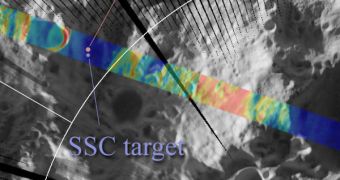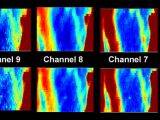The Lunar CRater Observation and Sensing Satellite (LCROSS) spacecraft crashed into the Cabeus crater at the south pole of the Moon on Friday, October 9, just minutes after releasing its spent Centaurus upper stage in a free dive. As they both collapsed to the surface, the “eyes” of dozens of telescopes were pointed at the scene. Also flying some 80 kilometers above was the Lunar Reconnaissance Orbiter (LRO), whose Diviner instrument was clicking away, capturing infrared pictures of the crash site. The first rough data have now been made public, PhysOrg reports.
The Diviner Instrument (Diviner Lunar Radiometer Experiment) usually measures thermal emissions on the lunar surface, in a bid to provide NASA experts with the best possible readings on where the most appropriate place to land humans in the future might be. The LRO passed above the impact site some 90 seconds after both spacecraft had already plummeted to their demise. It imaged the area in infrared wavelengths, at two-hour intervals, and from an angle 48 degrees off nadir.
Each of the instrument's detectors captured a 300 by 700-meter stretch of land in this configuration, the mission controllers announced. The first image clearly shows the two impact sites. NASA intentionally planned to slam LCROSS a few kilometers away from the Centaurus impact site, in order to get the best readings possible. Data from Diviner helped experts at the space agency select the Cabeus crater from a host of others, because it featured a permanently shadowed region, where water-ice might still exist.
The second image shows Diviner's all four thermal mapping channels recording the plume generated by the upper stage. The results are still rough and uncalibrated, but they offer clear evidence that the impact, indeed, took place at the calculated location. “We saw a crater. We saw a flash. So something had to happen in between,” NASA's principal investigator, Tony Colaprete, said after the crash. “The moon we thought we knew is not the moon we know now. The results that we'll get from LCROSS are an important piece in the puzzle of something that is pretty darn new, the hydration cycle on the moon,” Mike Wargo, NASA's chief lunar investigator, added.
He shared that, while the plume of dust ejected by the Centaurus stage was not observable in visible wavelengths, signs of it were detected with infrared instruments, proving for certain that the impact did occur as calculated. “We're just looking at the very preliminary images to get a sense of the types of data that have been collected. But it's too early to tell, to make that determination,” the LCROSS Observation Campaign lead investigator, Jennifer Heldmann, said.

 14 DAY TRIAL //
14 DAY TRIAL // 
